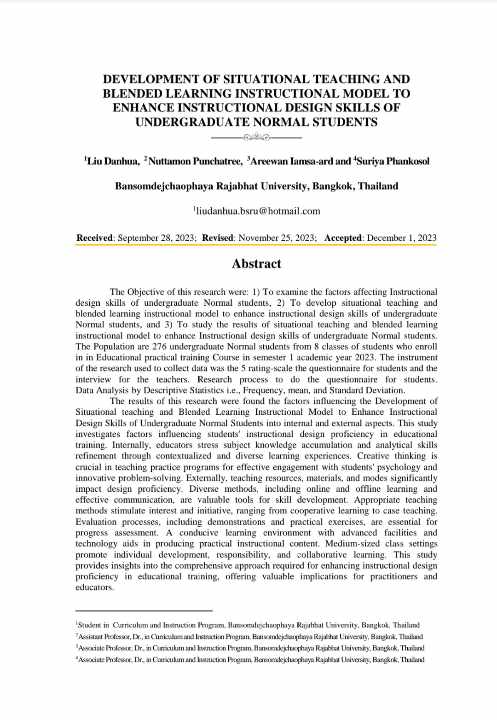Abstract
The Objective of this research were: 1) To examine the factors affecting Instructional design skills of undergraduate Normal students, 2) To develop situational teaching and blended learning instructional model to enhance instructional design skills of undergraduate Normal students, and 3) To study the results of situational teaching and blended learning instructional model to enhance Instructional design skills of undergraduate Normal students. The Population are 276 undergraduate Normal students from 8 classes of students who enroll
in in Educational practical training Course in semester 1 academic year 2023. The instrument of the research used to collect data was the 5 rating-scale the questionnaire for students and the interview for the teachers. Research process to do the questionnaire for students. Data Analysis by Descriptive Statistics i.e., Frequency, mean, and Standard Deviation. The results of this research were found the factors influencing the Development of
Situational teaching and Blended Learning Instructional Model to Enhance Instructional Design Skills of Undergraduate Normal Students into internal and external aspects. This study investigates factors influencing students’ instructional design proficiency in educational training. Internally, educators stress subject knowledge accumulation and analytical skills refinement through contextualized and diverse learning experiences. Creative thinking is crucial in teaching practice programs for effective engagement with students’ psychology and
innovative problem-solving. Externally, teaching resources, materials, and modes significantly impact design proficiency. Diverse methods, including online and offline learning and effective communication, are valuable tools for skill development. Appropriate teaching methods stimulate interest and initiative, ranging from cooperative learning to case teaching. Evaluation processes, including demonstrations and practical exercises, are essential for progress assessment. A conducive learning environment with advanced facilities and
technology aids in producing practical instructional content. Medium-sized class settings promote individual development, responsibility, and collaborative learning. This study provides insights into the comprehensive approach required for enhancing instructional design proficiency in educational training, offering valuable implications for practitioners and educators. In conclusion, this study underscores the intricate interplay of internal and external factors in cultivating students’ proficiency in instructional design. Creative thinking, diverse
teaching methods, optimal resources, and conducive environments emerge as pivotal elements. Acknowledging these influences is crucial for effective educational training programs and pedagogical advancement.
Keywords: Situational Teaching, Blended Learning, Instructional Design Skills
Liu Danhua, Nuttamon Punchatree, Areewan Iamsa-ard and Suriya Phankosol. (2023). DEVELOPMENT OF SITUATIONAL TEACHING AND BLENDED LEARNING INSTRUCTIONAL MODEL TO ENHANCE INSTRUCTIONAL DESIGN SKILLS OF UNDERGRADUATE NORMAL STUDENTS. MCU Ubonratchathani Journal of Buddhist Studies, Vol.5 No.3 (September-December, 2023), 5(3), 457-470. Retrieved from https://drive.google.com/file/d/1lKYFxsNuQTE0ZE_QffFT0LMBtBMfr8fX/view

